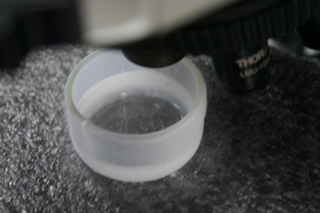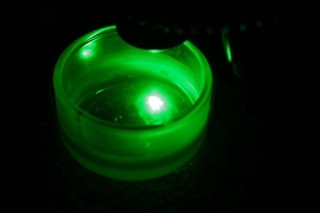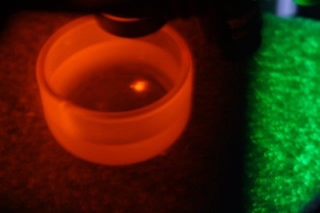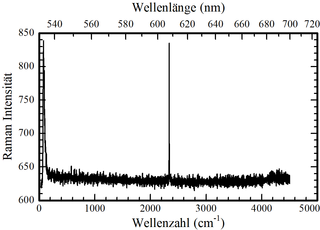What is Raman spectroscopy?
(This page is available in German / Diese Seite gibt es auch auf deutsch)
Raman spectroscopy is a technique to investigate oscillations within materials. These oscillations are called phonons and are typical for a given material
To do Raman spectroscopy, a sample must be illuminated by light. We are using an intense laser line for excitation. Usually, any light is just reflected which does not change its wavelength. But sometimes the light does excite (or annihilate) a molecular or lattice vibration within the material. Because such an oscillation / vibration / phonon has a specific energy and the fundamental law of energy conservation is still valid, the reflected light has in this case a different energy. Different energy means different wavelength and thus different color! Unfortunately, the Raman efffect is very weak and therefore usually not visible by the naked eye. However, here we show an example where the Raman effect can be visualized:
The Raman effect in (liquid) nitrogen
Our sample is a glass vessel filled by liquid nitrogen. It is placed under the Raman microscope.

The following picture is taken after switching on the green excitation laser:

However, the scattered green laser light is too intense and does dominate the picture. Therefore, to make the Raman effect visible, we have to find a possibility to filter out the laser light. We are using laser protection goggles which are put in front of the camera (please do not repeat this at home!). Our protection goggles filter out any wavelengths shorter than the laser light and the laser wavelength as well (this means violet, blue, turquoise, and green).


The sample immediately seems to be red! On the right side in the picture green scattered laser light remains visible because the camera is observing a larger area than covered by the laser protection goggles. This scattered light cannot be seen in the picture above because of the very short shutter opening time chosen for taking the photograph. The corresponding Raman spectrum is displayed as well. The red/orange light originates from the very sharp line at approximately 2335cm-1, which corresponds to about 607nm for a laser wavelength of 532nm. The molecular oscillation of N2 observed here has therefore an energy of about 2335cm-1.
We are investigating semiconductors, where the observed Raman lines are closer to the original laser excitation. Typical values are around several hundred wavenumbers which remains green (for 550cm-1 the wavelength is about 550nm, too, which is very hard to distinguish from the 532nm laser by the eye).